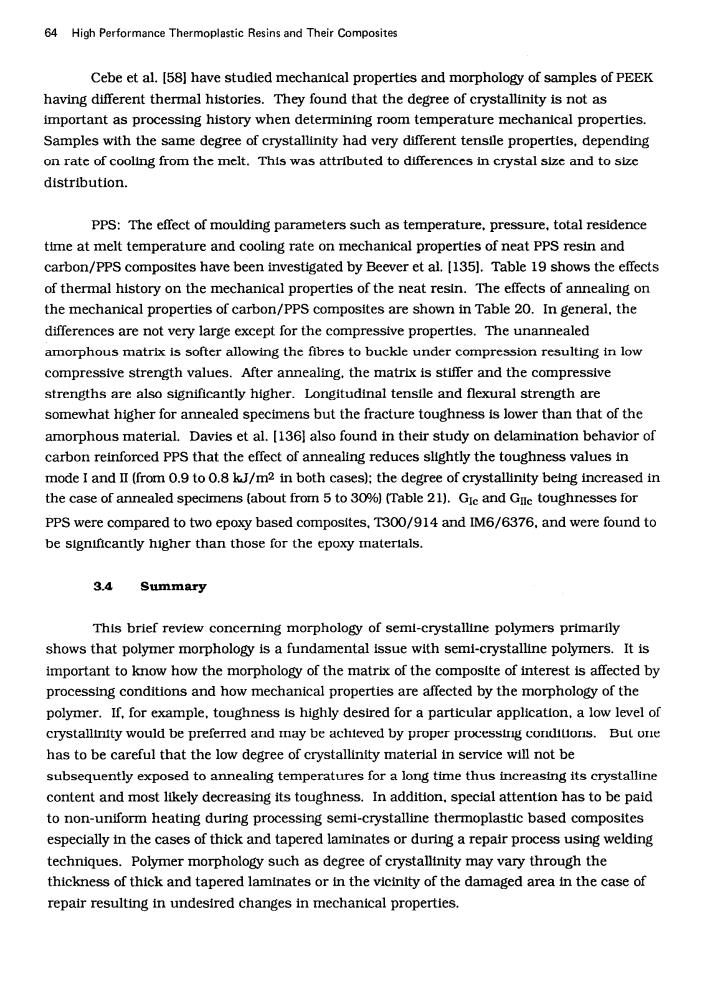正在加载图片...

64 High Performance Thermoplastic Resins and Their Composites Cebe et al.[58]have studied mechanical properties and morphology of samples of PEEK having different thermal histories.They found that the degree of crystallinity is not as important as processing history when determining room temperature mechanical properties. Samples with the same degree of crystallinity had very different tensile properties,depending on rate of cooling from the melt.This was attrlbuted to differences in crystal size and to size distribution. PPS:The effect of moulding parameters such as temperature,pressure,total residence time at melt temperature and cooling rate on mechanical properties of neat PPS resin and carbon/PPS composites have been investigated by Beever et al.[135].Table 19 shows the effects of thermal history on the mechanical properties of the neat resin.The effects of annealing on the mechanical properties of carbon/PPS composites are shown in Table 20.In general.the differences are not very large except for the compressive properties.The unannealed amorphous matrix is softer allowing the fibres to buckle under compression resulting in low compressive strength values.After annealing.the matrix is stiffer and the compressive strengths are also significantly higher.Longitudinal tensile and flexural strength are somewhat higher for annealed specimens but the fracture toughness is lower than that of the amorphous material.Davies et al.[136]also found in their study on delamination behavior of carbon reinforced PPS that the effect of annealing reduces slightly the toughness values in mode I and II (from 0.9 to 0.8 kJ/m2 in both cases);the degree of crystallinity being increased in the case of annealed specimens (about from 5 to 30%)(Table 21).GIe and Gne toughnesses for PPS were compared to two epoxy based composites,T300/914 and IM6/6376.and were found to be significantly higher than those for the epoxy materials. 3.4 Summary This brief review concerning morphology of semi-crystalline polymers primarily shows that polymer morphology is a fundamental issue with semi-crystalline polymers.It is important to know how the morphology of the matrix of the composite of interest is affected by processing conditions and how mechanical properties are affected by the morphology of the polymer.If,for example.toughness is highly desired for a particular application,a low level of crystalltnity would be preferred and may be achieved by proper processing condiuons.But one has to be careful that the low degree of crystallinity material in service will not be subsequently exposed to annealing temperatures for a long time thus increasing its crystalline content and most likely decreasing its toughness.In addition.special attention has to be paid to non-uniform heating during processing semi-crystalline thermoplastic based composites especially in the cases of thick and tapered laminates or during a repair process using welding techniques.Polymer morphology such as degree of crystallinity may vary through the thickness of thick and tapered laminates or in the vicinity of the damaged area in the case of repair resulting in undesired changes in mechanical properties.64 High Performance Thermoplastic Resins and Their Composites Cebe et al. [58] have studied mechanical properties and morphology of samples of PEEK having different thermal histories. They found that the degree of crystallinity is not as important as processing history when determining room temperature mechanical properties. Samples with the same degree of crystallinity had very different tensile properties, depending on rate of cooling from the melt. This was attributed to differences in crystal size and to size distribution. PPS: The effect of moulding parameters such as temperature, pressure, total residence time at melt temperature and cooling rate on mechanical properties of neat PPS resin and carbon/PPS composites have been investigated by Beever et al. [ 1351. Table 19 shows the effects of thermal history on the mechanical properties of the neat resin. The effects of annealing on the mechanical properties of carbon/PPS composites are shown in Table 20. In general, the differences are not very large except for the compressive properties. The unannealed amorphous matrix is softer allowing the fibres to buckle under compression resulting in low compressive strength values. After annealing, the matrix is stiffer and the compressive strengths are also significantly higher. Longitudinal tensile and flexural strength are somewhat higher for annealed specimens but the fracture toughness is lower than that of the amorphous material. Davies et al. [ 1361 also found in their study on delamination behavior of carbon reinforced PPS that the effect of annealing reduces slightly the toughness values in mode I and II (from 0.9 to 0.8 kJ/ms in both cases): the degree of crystallinity being increased in the case of annealed specimens (about from 5 to 30%) (Table 2 1). G1, and Gac toughnesses for PPS were compared to two epoxy based composites, T300/914 and IM6/6376. and were found to be significantly higher than those for the epoxy materials. 3.4 Summary This brief review concerning morphology of semi-crystalline polymers primarily shows that polymer morphology is a fundamental issue with semi-crystalline polymers. It is important to know how the morphology of the matrix of the composite of interest is affected by processing conditions and how mechanical properties are affected by the morphology of the polymer. If, for example, toughness is highly desired for a particular application, a low level of crystallinity would be preferred and may be achieved by proper processing conditions. But one has to be careful that the low degree of crystallinity material in service will not be subsequently exposed to annealing temperatures for a long time thus increasing its crystalline content and most likely decreasing its toughness. In addition, special attention has to be paid to non-uniform heating during processing semi-crystalline thermoplastic based composites especially in the cases of thick and tapered laminates or during a repair process using welding techniques. Polymer morphology such as degree of crystallinity may vary through the thickness of thick and tapered laminates or in the vicinity of the damaged area in the case of repair resulting in undesired changes in mechanical properties